|
ANDREW THOMSON, SR. (1831-1919)
AUTOBIOGRAPHY | ||||||||||||||||||||
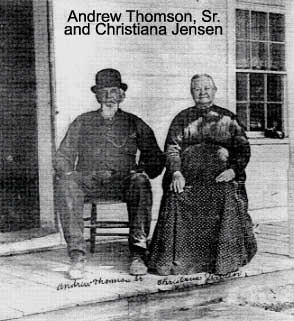 I was born on December 4, 1831 in the village of Falquverslov on the island of Falster. My parents were Thomas Thomson (Nielson) and Dorthea Anderson. My father died when I was about 5 1/2 years old and mother married Peter Peterson Thomson. I grew up by my stepfather, working on the farm, and remaining with him until I became twenty-one years of age. I received a common school education. At this period of my life the gospel had been brought to us. I accepted it, and on June 28th 1852 I was baptized into the Church of Jesus Christ of Latter-day Saints by John Swenson.
I was born on December 4, 1831 in the village of Falquverslov on the island of Falster. My parents were Thomas Thomson (Nielson) and Dorthea Anderson. My father died when I was about 5 1/2 years old and mother married Peter Peterson Thomson. I grew up by my stepfather, working on the farm, and remaining with him until I became twenty-one years of age. I received a common school education. At this period of my life the gospel had been brought to us. I accepted it, and on June 28th 1852 I was baptized into the Church of Jesus Christ of Latter-day Saints by John Swenson.
In December of that year a large emigration left Denmark enroute to Utah, and I was one of the number which came from Copenhagen. We crossed the Atlantic on the sailing ship "Forest Monarch". We were about eleven weeks on the ocean having had to come across the water in sailing vessels. We landed in New Orleans and there sailed up the Mississippi River in steamboats to St. Louis, where we stayed for some time. From here we went to a city named Keokuk, Iowa where we obtained ox teams. In the spring of 1853 we began our journey across the plains under the leadership of John Fosgreen, who had been our guide on both land and sea from the time we left Denmark until the present. 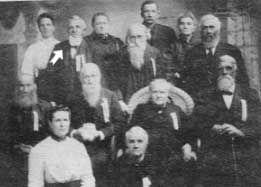 On September 30, 1853 we arrived in Salt Lake City. After only a days stay in the city, a part of our company was directed, by Patriarch James Allred and his son Reuben up here to Sanpete, to a place called Spring City. In those days there was trouble with the Indians and we had to stand guard to protect ourselves at night.
On September 30, 1853 we arrived in Salt Lake City. After only a days stay in the city, a part of our company was directed, by Patriarch James Allred and his son Reuben up here to Sanpete, to a place called Spring City. In those days there was trouble with the Indians and we had to stand guard to protect ourselves at night.
On arriving here at Spring City, which was about the middle of October, we had some ox teams which had to be cared for, so the first thing we did was to go down here to canal bottom and cut some frozen grass and haul it up to the place where we were staying. When we had done this, we had to build a fort wall so we could protect ourselves in case the Indians should make an attack on us. At this time we were about out of provisions, so we divided ourselves into two parties. The plan was laid that one party should stay home and build the fort walls and the other should go down into Utah County and work to earn provisions. It was further agreed that the party, which stayed home, should build the other parties share of the fort wall and that those who sent to work should divide the provisions they earned with those who stayed home. I was one of the party who went down to work. We worked until we had earned enough to fill our wagons with potatoes and other things, which we brought home with us. We were now prepared to stay here and make our homes, but in December of the same year there came word from our leaders in Salt Lake that it was not considered safe for us to stay here through the winter because of our being so few in number that the Indians might make a raid upon us, and we would not be able to defend ourselves. So we were counseled to move up to Manti. The people here were liberal and kindhearted and gave us rooms so that we could stay, and this we did through that winter.
Early the next spring, that of 1854, a company joined together, I being one of the company, and moved down here to Ephraim. Again we found it necessary to build a fort for our protection, the rock for which, we quarried and hauled from above the town. This done, we built a corral in which to put our cattle in order that the Indians could not steal them. Now we had to commence to farm, but before the crop could be put in we had to grub the brush from the land. We had poor tools to work with but we did the best we could, and got in a little crop that first year although it became late in the season before we got it done. Then we had to get the water ditches made and the water out on the ground so it became late before the grain began to grow. On account of it's being late, the grain did not have time enough to mature before the frosts set in and some of our crop was frozen. We obtained some, however, which was not frozen.
In the fall of 1854 a large company came in from Scandinavia and a lot of them came up to Ephraim and settled. The winter of that year was a kind of a dry open one. Due to this increase in our numbers it was necessary to have another fort in order that all might have protection, therefore, we had to quarry and haul rock again that winter. In the spring of 1855 we put in another crop and the grain came up all right, but the fall previous the grasshoppers had come in and laid their eggs which now hatched after the grain had come up and ate all of it. This left a kind of a dark picture before us. There was not very much grain in the country, so the people had to go out and see what they could find to live on. This year we raised a pretty good crop of potatoes, which helped us out a great deal. I, in connection with three other brethren went out to Cedar City. They had raised some wheat there, some of which we bought and brought home with us. So we got along pretty well. There were some, however, who had to live on potatoes aloe, and they did not all have enough of them. Some had to dig roots and pull weeds to live on until the next harvest. This was about the end of the second year since we came here. After that we raised crops and did a little better. We always had to be on our guard for the Indians for they were treacherous and would steal a little when they would get an opportunity. I lived unmarried for the first four years after we came here, or until the fall of 1857, when a handcart company came in. Amongst these was a family composed of Andrew Jensen, his wife, and two daughters; Christiana and Maryanna. I got acquainted with Christiana and we agreed to get married. We were married November 21, 1857. She had helped to pull a handcart thirteen hundred miles by the side of her father. (They lived together to celebrate their Golden Wedding Anniversary and then five and one half years more.) 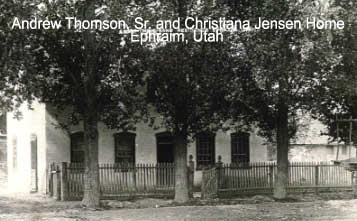 The next thing to do, having got me a companion, was to provide a home, this was a one room building in the little fort. It was located on about the spot where Andrew (my son lived, just across the road from Snow College and there is where he was born and my daughter, Dianthy, also.) We lived there about three years. About this time the city was laid out and in casting lots, I drew the lot on the corner of Center and Second East where the old home now stands. Thomas P. was born in 1862 and another daughter was born there in 1864. (Since then, the home has been torn down but it was located on the southeast corner of the college block.) Ten years had now passed since the beginning of Ephraim and everything was moving along pretty well.
The next thing to do, having got me a companion, was to provide a home, this was a one room building in the little fort. It was located on about the spot where Andrew (my son lived, just across the road from Snow College and there is where he was born and my daughter, Dianthy, also.) We lived there about three years. About this time the city was laid out and in casting lots, I drew the lot on the corner of Center and Second East where the old home now stands. Thomas P. was born in 1862 and another daughter was born there in 1864. (Since then, the home has been torn down but it was located on the southeast corner of the college block.) Ten years had now passed since the beginning of Ephraim and everything was moving along pretty well.
Then in the fall of the same year 1864 another call came from headquarters to move south and in the month of October we left Ephraim to find a new home. We located in Piute County in the little place called Circleville. It was necessary to build another log cabin where we could nestle down for the winter and in the mean time we had Indian troubles to contend with. However in 1865 we planted crops and raised sufficient for our needs. While here one of our little girls died, Anna Marie and in June 1866 another little girl came to our home, Hannah Mary. About this time the Indians were very treacherous and on the warpath killing some people and stealing their livestock. I had five cows, one heifer and a steer stolen. By this time it was thought unsafe for us to remain as we were only a small company, so by order of Brigham Young, Daniel H. Wells was sent out there to release us and to send us back. We left June 1866 and came back to Ephraim and back to our old home, which we had not sold, once more to start life anew. The Indians were still on the warpath and not until the year of 1867 was the treaty of peace signed.
During these years the grasshoppers ate almost everything. Also during these years the Walker war and also the Black Hawk war had been raging. I passed through all the trials and hardships incident to pioneer life. It might be of interest to you to know some of the names of the Indian Chiefs. They are Chief Wacker, White Horse Chief, Old Aropine, Old Tapiv, Joe Indian, and Black Hawk. I also owned a racehorse whose name was Peacock, and he made an express run of 110 miles in one day. The country he covered was left Monroe to Richfield, then to Marysvale, Circleville and back to Richfield. Andrew Theiry was the rider.
| ||||||||||||||||||||
These are a few incidents from Grandfather's life:
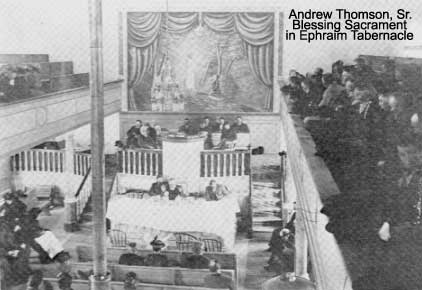 He held the offices of Elder and Seventy in the church and was a member of the 47th Quorum of Seventys. In 1877 he became a High Priest and was chosen second counselor to Bishop Lars S. Anderson of Ephraim North Ward. Later he became a first counselor and served in the Bishopric for twenty-four years.
He held the offices of Elder and Seventy in the church and was a member of the 47th Quorum of Seventys. In 1877 he became a High Priest and was chosen second counselor to Bishop Lars S. Anderson of Ephraim North Ward. Later he became a first counselor and served in the Bishopric for twenty-four years.
To add a little humor to the story, the Thomson's home was noted for its hospitality. Friends and conference visitors often came to eat. One day Bishop Anderson was there to dinner and while talking he put a bite of Christiana's own mustard mixture in his mouth. He threw up his arms and said, "O" God, save my eyes, my nose has gone." 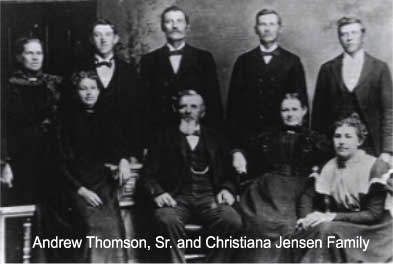 Andrew Thomson, Sr. was a very devoted father and each morning, real early, he would make the rounds to call on his children who lived within two blocks each way. The only word we ever heard him use in the way of slang or swearing was "goss."
Andrew Thomson, Sr. was a very devoted father and each morning, real early, he would make the rounds to call on his children who lived within two blocks each way. The only word we ever heard him use in the way of slang or swearing was "goss."
Grandfather was very clean and neat about his person and particularly about his clothing. His farm was keep clean from weeds. He was thrifty and efficient in all of his activities. He was serious minded in all sacred things. He was fond of music, especially sacred songs, however, when "Just Because She Made Those Goo-Goo Eyes" came out it made a hit with him. Even though it was a bit frivolous he often asked his granddaughter to sing "Goofey Eyes" for him. He also like the song "Star of the East." The family had a lovely organ. He enjoyed having family gatherings at the home where the spirit of love prevailed. He was interest in the salvation of his ancestors and made many trips my horse and buggy to the Manti Temple in the winter as well as in the summer. He was the father of ten children, five boys and five girls:
Andrew Thomson, Sr. died April 5, 1919 at the age of 88 years of age at home in Ephraim, Utah. |